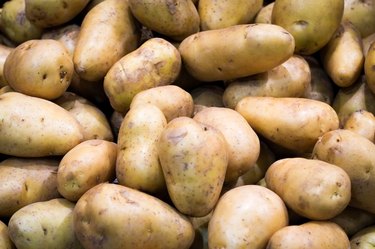
Plants produce starch and use it to store carbohydrates for energy. When you consume foods that contain starch, it becomes an important source of energy for your body. Starches, or complex carbs, consist of two molecules -- amylose and amylopectin -- that connect together to form starch granules. Amylose and amylopectin have different characteristics, which define the different types of starches.
Slowly Digested Starch
Video of the Day
Amylose contains 500 to 20,000 molecules of glucose connected together in a straight chain. The chain twists into a helix and then two chains bond together, forming a structure that resists the digestive enzymes trying to break the glucose molecules apart. As a result, amylose is slowly digested and absorbed, which is why it's called a slowly digestible starch. Amylose can help keep your blood sugar balanced because it does not cause a large spike in blood sugar levels. About 20 to 30 percent of the natural starch in plants consists of amylose.
Video of the Day
Rapidly Digested Starch
Amylopectin is significantly larger than amylose, with a structure made up of millions of glucose molecules that branch out and form a crystalline structure. Its glucose units are easily cleaved during digestion, which makes it a rapidly digestible starch. Amylopectin can boost your blood sugar temporarily, but it is followed by a hunger-producing drop in blood sugar. About 70 to 80 percent of the total natural starch in plants is made up of amylopectin.
Resistant Starch
The third type of starch -- resistant starch -- is not digested, but it is fermented by bacteria in your colon. The fermentation of starch produces short chain fatty acids that provide energy for cells in your large intestine. There are several types of resistant starches. The first type, which is found in beans, seeds, whole grains or partially milled grains, is protected from digestion because it is inside cell walls. The second type contains high amounts of amylose, which are naturally resistant. This type comes from potatoes, corn and starchy fruits such as bananas. The third type, found in bread, potatoes and rice, becomes more resistant after it's cooked and cooled.
Starch Sources
Foods that contain starch usually have all three types, so it's not easy to create lists of foods that are better sources of one type over the other, reports an article published in "Nutrients" in March 2011. The top sources of total starch are grains, beans and starchy vegetables such as potatoes, corn and peas. You'll also get a smaller amount from nuts, seeds, non-starchy vegetables and fruits. Some starches are extracted from corn or other plants and chemically modified to make them more resistant to digestion. They form a fourth group of resistant starches.